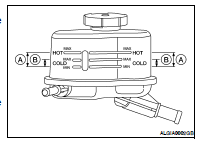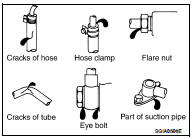Nissan Altima (L32) 2007-2012 Service Manual: Power steering fluid
Inspection
FLUID LEVEL
• Check fluid level with engine stopped.
• Make sure that fluid level is between MIN and MAX.
• Fluid levels at HOT (A) and COLD (B) are different. Do not confuse them.


CAUTION: • The fluid level should not exceed the MAX line. Excessive fluid will cause fluid leakage from the cap.
• Do not reuse drained power steering fluid.
• Recommended fluid is Genuine Nissan PSF or equivalent.
FLUID LEAKAGE
Check hydraulic connections for fluid leakage, cracks, damage, looseness, or wear.
1. Run engine until the fluid temperature reaches 50 to 80° C (122 to 176°F) in reservoir tank, and keep engine speed idle.
2. Turn steering wheel several times from full left stop to full right stop.
3. Hold steering wheel at each lock position for five seconds and carefully, check for fluid leakage.
CAUTION: Do not hold the steering wheel in a locked position for more than 10 seconds. (There is the possibility that oil pump may be damaged.) 4. If fluid leakage at connections is noticed, then loosen flare nut and then retighten. Do not overtighten connector as this can damage O-ring, washer and connector.
5. If fluid leakage from oil pump is noticed, check oil pump. Refer to ST-31 (QR25DE), ST-31 (VQ35DE).
6. Check steering gear boots for accumulation of fluid indicating from steering gear.

Draining
1. Disconnect both high and low pressure lines from power steering gear.
2. Drain into a suitable container.
Refilling
FILLING HYDRAULIC SYSTEM
1. Fill power steering reservoir while checking fluid level.
2. Bleed air from hydraulic system.
3. Check for fluid leaks.
AIR BLEEDING HYDRAULIC SYSTEM
If air bleeding is not complete, the following symptoms can be observed.
• Bubbles are created in reservoir tank.
• Clicking noise can be heard from oil pump.
• Excessive buzzing in the oil pump.
NOTE:
Fluid noise may occur in the steering gear or oil pump. This does not affect performance or durability of the system.
1. Turn steering wheel several times from full left stop to full right stop with engine off.
CAUTION: Turn steering wheel while filling reservoir tank with fluid so as not to lower fluid level below the MIN line. 2. Start engine and hold steering wheel at each lock position for 3 seconds at idle to check for fluid leakage.
3. Repeat step 2 above several times at approximately 3 second intervals.
CAUTION: Do not hold the steering wheel in a locked position for more than 10 seconds. (There is the possibility that oil pump may be damaged.) 4. Check fluid for bubbles and while contamination.
5. Stop engine if bubbles and white contamination do not drain out. Perform step 2 and 3 above after waiting until bubbles and white contamination drain out.
6. Stop the engine, and then check fluid level.

 On-vehicle maintenance
On-vehicle maintenance Steering wheel
Steering wheel